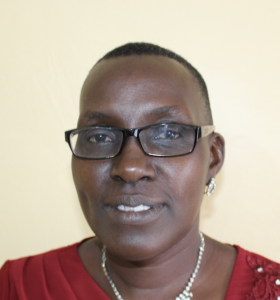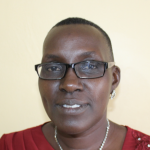Ngovilo Spring is located in a rural area of Bukhankunga Community. There are a lot of indigenous trees around and lots of sugarcane and maize farmlands. The buildings are made of either mud or grass thatching with very few semi-permanent structures around. It is a peaceful community of 175 people who are often found busy on their farms.
Most of these people are small-scale farmers. A few of the men work as boda boda (motorbike taxi) drivers. An average day starts at 6am. The women wake up and prepare the children for school. After that, they prepare breakfast and set the table. They rush to Ngovilo Spring and fetch water.
The water source is located in a busy area of the community. The water is contaminated by nearby households and farms. We noticed sugarcane farming up the slope which opens the spring to contamination when it rains. The water gathers around the collection point for people to gather each day.
Access is challenging because of the bushy environment that has been allowed to crowd the water source. People fill their containers with water from an old pipe that is rusted and rotted due to contaminants from the fertilizers around the farms that surround the spring.
As a result, the water is unsafe for consumption.
"I'm worried for my children because the water from the spring is not safe for them to drink," said Phylis Nyongesa to us during a visit to the spring.
People suffer from waterborne diseases and mosquitoes that cause malaria breed in the stagnant water. Protecting the spring and carrying out training on hygiene and sanitation will help ensure that the water is safe and community members take appropriate steps to not contaminate the source.
After fetching the water, the women come back to sweep the compound and wash clothes. For those who have cows and goats, they go and tie them where they can graze. They then go to work on the family farm until midday when they return home to prepare lunch for the children. After lunch, they go fetch wood and fetch more water to use for bathing and for cooking in the evening. They then prepare dinner around 6pm, the family eats, and then retires to bed.
What we can do:
Training
Community members will attend hygiene and sanitation training for at least two days. This training will ensure participants have the knowledge they need about healthy practices and their importance. The facilitator plans to use PHAST (Participatory Hygiene and Sanitation Transformation), CLTS (Community-Led Total Sanitation), ABCD (Asset-Based Community Development), group discussions, handouts, and demonstrations at the spring. One of the most important topics we plan to cover is the handling, storage, and treatment of water. Having a clean water source will be extremely helpful, but it is useless if water gets contaminated by the time it’s consumed. Handwashing will also be a big topic.
Training will also result in the formation of a committee that will oversee operations and maintenance at the spring. They will enforce proper behavior around the spring and delegate tasks that will help preserve the site, such as building a fence and digging proper drainage. The fence will keep out destructive animals, and the drainage will keep the area’s mosquito population at a minimum.
Sanitation Platforms
On the final day of training, participants will select five families that should benefit from new latrine floors.
Training will also inform the community and selected families on what they need to contribute to make this project a success. They must mobilize locally available materials, such as bricks, clean sand, hardcore, and ballast. The five families chosen for sanitation platforms must prepare by sinking a pit for the sanitation platforms to be placed over. All community members must work together to make sure that accommodations and food are always provided for the work teams.
Spring Protection
Protecting the spring will ensure that the water is safe, adequate and secure. Construction will keep surface runoff and other contaminants out of the water. With the community’s high involvement in the process, there should be a good sense of responsibility and ownership for the new clean water source.
Fetching water is predominantly a female role, done by both women and young girls. Protecting the spring and offering training and support will, therefore, help empower the female members of the community by giving them more time and efforts to engage and invest in income-generating activities.

 Protected Spring
Protected Spring
 Rehabilitation Project
Rehabilitation Project





































